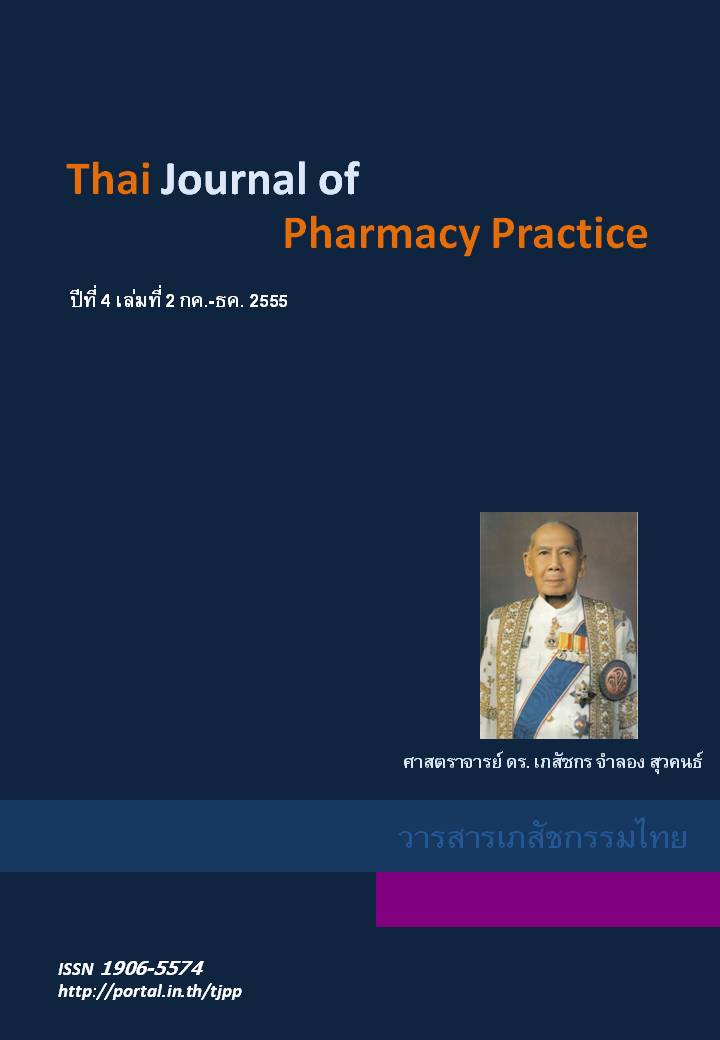ความเป็นวิชาชีพเภสัชกรรมของนิสิตนักศึกษาเภสัชศาสตร์ในประเทศไทย
Main Article Content
บทคัดย่อ
วัตถุประสงค์: เพื่อสำรวจระดับความเป็นวิชาชีพเภสัชกรรมและวิเคราะห์ความสัมพันธ์ระหว่างการขัดเกลาทางวิชาชีพกับความเป็นวิชาชีพของนิสิตนักศึกษาเภสัชศาสตร์ในประเทศไทย วิธีการวิจัย: การสำรวจใช้แบบสอบถามชนิดกรอกด้วยตนเอง ซึ่งผ่านการประเมินความตรงเชิงผิวหน้าโดยผู้เชี่ยวชาญ 3 คน และผ่านการศึกษานำร่องในนิสิตคณะเภสัชศาสตร์ 61 คน การประเมินความเชื่อมั่นของเครื่องมือใช้ค่าครอนบัค อัลฟ่า ผู้วิจัยเก็บข้อมูลจากนิสิตนักศึกษาในหลักสูตรเภสัชศาสตรบัณฑิตทั่วประเทศระหว่างเดือนกรกฎาคม 2553 ถึงพฤษภาคม 2554 การวิเคราะห์ความสัมพันธ์ระหว่างการขัดเกลาทางวิชาชีพกับความเป็นวิชาชีพเภสัชกรรมใช้การวิเคราะห์ถดถอยพหุ โดยกำหนดระดับนัยสำคัญของการวิเคราะห์ที่ 0.05 ผลการวิจัย: นิสิตนักศึกษาให้ความร่วมมือตอบแบบสอบถามที่นำมาวิเคราะห์ได้ทั้งสิ้น 1,443 คน คิดเป็นอัตราการตอบกลับร้อยละ 57.7 เมื่อพิจารณาในภาพรวม นิสิตนักศึกษามีคะแนนความเป็นวิชาชีพเภสัชกรรม 171.1±14.9 คะแนน จากคะแนนที่เป็นไปได้ 42-210 คะแนน นับว่าอยู่ในระดับปานกลางถึงสูง นิสิตนักศึกษามีระดับความเป็นวิชาชีพสูงสุดในมิติ “ความเชื่อมั่นในความสำคัญของวิชาชีพต่อสังคม” ตามด้วย “ความเชื่อมั่นในความสำคัญของการศึกษาต่อเนื่อง” “การยอมรับองค์กรทางวิชาชีพและมาตรฐานต่างๆ ขององค์กร” “ความเชื่อว่าวิชาชีพควรปกครองตนเองโดยบุคคลในวิชาชีพ” “ความเชื่อว่าการประกอบวิชาชีพควรมีความเป็นอิสระ” และ “ความผูกพันต่อวิชาชีพและความภูมิใจที่ได้อยู่ในวิชาชีพ” ซึ่งมีคะแนนต่ำสุด การขัดเกลาทางวิชาชีพมีความสัมพันธ์เชิงบวกกับความเป็นวิชาชีพของนิสิตนักศึกษาเภสัชศาสตร์ (r=0.585, p<0.001) เมื่อพิจารณาอำนาจการทำนายพบว่า ปฏิสัมพันธ์กับอาจารย์แหล่งฝึกทักษะเชิงวิชาชีพ ปฏิสัมพันธ์กับเพื่อน ปฏิสัมพันธ์นอกชั้นเรียนกับอาจารย์ การรับรู้ว่าอาจารย์ใส่ใจในพัฒนาการของตนเอง และพัฒนาการด้านองค์ความรู้และสังคม สามารถร่วมกันทำนายความผันแปรของความเป็นวิชาชีพเภสัชกรรมของนิสิตนักศึกษาได้ร้อยละ 35.4 สรุป: นิสิตนักศึกษาเภสัชศาสตร์มีคะแนนในมิติความสำคัญของวิชาชีพเภสัชกรรมต่อสังคมสูงที่สุด และมีความผูกพันต่อวิชาชีพและความภูมิใจที่ได้อยู่ในวิชาชีพน้อยที่สุดเมื่อเทียบกับมิติอื่น การขัดเกลาทางวิชาชีพเป็นตัวทำนายที่สำคัญต่อความเป็นวิชาชีพเภสัชกรรมของนิสิตนักศึกษา ด้วยเหตุนี้ สถาบันการศึกษาควรให้ความสำคัญกับการขัดเกลาทางวิชาชีพควบคู่ไปกับการพัฒนาการจัดการเรียนการสอนในหลักสูตรตามปกติ
Article Details
ผลการวิจัยและความคิดเห็นที่ปรากฏในบทความถือเป็นความคิดเห็นและอยู่ในความรับผิดชอบของผู้นิพนธ์ มิใช่ความเห็นหรือความรับผิดชอบของกองบรรณาธิการ หรือคณะเภสัชศาสตร์ มหาวิทยาลัยสงขลานครินทร์ ทั้งนี้ไม่รวมความผิดพลาดอันเกิดจากการพิมพ์ บทความที่ได้รับการเผยแพร่โดยวารสารเภสัชกรรมไทยถือเป็นสิทธิ์ของวารสารฯ
เอกสารอ้างอิง
2. Kerr S, von Glinow MA, Schiesheim J. Issues in the study of professionals in organization: the case of scientists and engineers. Organ Behav Hum Perf 1977;18:329-45.
3. Bartol KM. Professionalism as a predictor of organizational commitment, role stress, and turnover: a multidimensional approach. Acad Manage J 1979;22:815-21.
4. Snizek WE. Hall’s professionalism scale: an empirical reassessment. Am Sociol Rev 1972;37:109-14.
5. Hammer DP. Professional attitudes and behavior: the “A’s and B’s” of professionalism. Am J Pharm Educ 2000;64:455-64.
6. Anderson DJ. The hidden curriculum. AJR 1992;159:21-2.
7. Karnieli-Miller O, Vu R, Holtman MC, Clyman SG, Inui TS. Medical students’ professionalism narratives: a window on the informal and hidden curriculum. Acad Med 2010;85:124-33.
8. Chaichalermpong W. Factors affecting learning outcomes from hidden curriculum which influence professionalism of pharmacy students [dissertation]. Bangkok: Chulalongkorn University; 2004.
9. American College of Clinical Pharmacy. ACCP white paper: development of student professionalism. Pharmacotherapy 2009;29:749-56.
10. Lerkiatbundit S. Professionalism in Thai pharmacy students. J Soc Admin Pharm 2000;17:51-8.
11. Ploylearmsang C, Satayavongthip B, Suttajit S, Arpasrithongsakul S. Students’ professionalism and leadership influenced by pharmacy education and institutional socialization. Isan Journal of Pharmaceutical Sciences 2006;2:1-12.
12. Lerkiatbundit S. Factor structure and cross-validation of a professionalism scale in pharmacy students. Journal of Pharmacy Teaching 2005;12:25-49.
13. The Pharmacy Council regulation on pharmacy curriculum and certificate, or pharmacy profession diploma of various institutions for the purpose of membership application of 2551 B.E. Government Gazette. No 125 Special Section 67 D. 3 April 2008.
14. Bartlett JE, Kotrlik JW, Higgins CC. Organizational research: determining appropriate sample size in survey research. Information Technology, Learning, and Performance Journal 2001;19:43-50.
15. Cohen J. Statistical power analysis for the behavioral sciences. 2nd ed. Hillsdale, NJ: Lawrence Erlbaum; 1998.
16. Blau GJ. Further exploring the meaning and measurement of career commitment. J Voc Beh 1988;32:284-97.
17. Fjortoft NF, Lee MWL. Developing and testing a model of professional commitment. Am J Pharm Educ 1994;58:370-8.
18. Manesse HR, Stewart JE, Hall RH. Inconsistent socialization in pharmacy—a pattern in need of change. In: Wetheimer AI, Smith MC, editors. Pharmacy
practice: social and behavioral aspects. 2nd ed. Baltimore, MD: University Park Press; 1981. p. 37-54.
19. Schwirian PM, Facchinetti NJ. Professional socialization and disillusionment: case of pharmacy. Am J Pharm Educ 1975;39:18-23.
20. Jackson J. Normative power and conflict potential. Sociol Method Res 1975;4:237-63.


